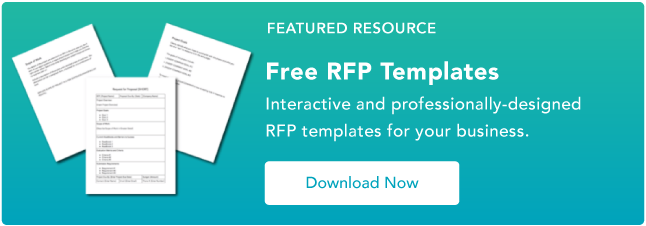
As the end of the calendar year nears, RFP’s are likely going to be coming out fast and furious. Sadly, we can all probably agree that the RFP process likely isn’t going away anytime soon. But that doesn’t mean we have to like it. Nor does it mean that we can’t try and change it.
Every agency understands the challenges clients face in trying to find the perfect fit -- the agency that “gets you,” that you can trust, that you want to have a beer with, and that will become a trusted advisor to you and your brand. Please know, that’s exactly what we want too ... but the standard RFP process is a broken way to go about it.
So, how about we try to fix them?
Download Now: Free RFP Templates
Don't Send Out That RFP Without These 7 Things
1) Give us a budget. Seriously, give us one.
Prevailing wisdom says that by withholding budget information, you will increase competition among agencies and therefore you’ll get better value from them. Or you might feel like revealing your budget too early will give away too much, leading to ideas and scope beyond your means. Trust us, agencies have heard all of the reasons. We simply ask you to remember these things: Every agency will interpret your RFP differently and therefore, scope it differently. So even if your RFP is fairly detailed, you’re still getting an apples-to-oranges comparison dictated by the whims of the agencies responding, which generally defeats the purpose of an RFP.
How this will benefit you:
Like most businesses, agencies must consider the scale when taking on projects. Not giving a budget range can potentially waste your time and the agency's time figuring out if the relationship is a good fit. Additionally, you need to take into consideration the size of agencyyouwant to work with. We understand the process of looking for a new agency just adds to your day-to-day responsibilities. Providing a budget range will help you narrow down to a short list more quickly.
2) Don’t ask us to give you “initial thoughts” of your website or other vague requests.
When you ask questions like this, agencies will spend time looking at your website or other marketing materials to try their best to extrapolate what’s right and wrong with it without knowing what they’re trying to solve. Without the benefit of your business objectives, goals, and previous results, you’re asking an agency to speculate (at best) or provide actionable insights (at worst), which will impact your opinion of the firm early in the selection process. Do this early in the process, and you’ll receive feedback that isn’t much more insightful than looking into a crystal ball.
How this will benefit you:
Instead, consider sharing things that aren’t working in your marketing plan, website, content, etc., that you’vealready identifiedbased on your expertise and brand knowledge. Provide agencies with the problems to see how they would solve them.
Not only will this give you insight into how the agency thinks (which should really be the main objective of any RFP), but once you choose an agency, that will be the ideal model for the first stages of the relationship. It will also give you a much better apples-to-apples comparison of the agencies you’re evaluating.
3) Be realistic about your timeframes.
This includes not only the project you’re looking to get done, but the time you’re giving agencies to participate in the RFP itself. If you are expecting agencies to turn a full response in 7–14 days, and they do so, please be courteous and stick to your own deadlines as well. On the agency-side, we’re constantly evaluating prospects as potential partners, too. And if you slide your own deadlines in the RFP process, it makes us wonder if pushing internal deadlines will be a cultural thing we’ll have to work with when we’re facing feedback and approval schedules.
How this will benefit you:
Allocating time to allow for questions will help agencies tailor their responses even more effectively, and this will also give you insight into their thinking processes. And, being respectful of the time agencies are putting into their responses shows your ability to partner when both parties are on deadline.
4) Seriously ... provide a budget.
See #1. But really, this is such a big point, it can’t be over-emphasized enough. Even if you truly don’t (or can’t) have a specific budget in mind, you likely have a maximum budget tolerance in your head. Even that would be a good starting point for an agency.
How this will benefit you:
Trust us, not all agencies are wired to scope to the highest budget amount. If you tell us you have a maximum budget of $250,000, but you know you will allocate some of that to other projects, that gives us way more to go on then simply saying “I don’t have a budget.” And you’re greatly increasing the likelihood that the responses you receive will be more relevant to your needs.
5) Be OK with digital copies.
This isn’t as big of a deal, but since we’re talking dream scenarios, I might as well mention it. Yes, your committee might prefer hard copies, but your agency partners will greatly appreciate the ease and convenience (and extra time) that delivering a digital copy provides. It’s a very considerate trade-off for agencies that are going to be putting thousands of dollars worth of time into responding to your RFP. Plus it’s better for Mother Earth, c’mon.
How this will benefit you:
Frankly, this one benefits agencies more, we understand that. But one out of seven isn’t overly selfish, is it?
6) Don’t treat this as an exercise for your budgeting purposes.
This may sound a bit defensive, but bear with me. At Struck, we decline to participate in most RFPs if the brand doesn't list a budget. Sadly, we’ve learned that, more often than not, these never materialize into anything. Over and again, we’d send out responses to these types of RFPs, and they would just go into the ether, rarely meriting any answer from the client at all. It made us realize these clients are probably using the RFP process to help determine prices for comparisons to existing budgets, fiscal planning, or even internal persuasion. The prospect doesn’t have any intention of awarding the project.
We understand why you’d want more information on how much a new website may cost (as an example), but putting an agency through a full RFP process you aren’t intending to award makes us sad (and the only cure is puppies and whiskey).
How this will benefit you:
Asking an agency to simply compete on price at that stage doesn’t give an agency a true opportunity to talk about our strengths, and it reduces our services to a commodity business.
Rather, if you do need help with your budgeting or making an internal case for a project, let us know up front and we’re generally happy to help you in that regard, particularly if we know we’re likely to be awarded the business. See the conclusion below, but if you truly need help determining what your budget and marketing needs are, it’s better to evaluate agencies on chemistry before ever getting to any price conversations.
7) Ask yourself if you really need an agency.
This is super-subjective and may not always be the case, but as design and web development tools have become more ubiquitous (thank you Squarespace), more clients seem to want to parse out pieces of their business, particularly on the digital side, while moving many projects of it in-house. On the agency-side, we don’t begrudge you this. We understand working with a fully integrated agency on all your marketing materials can be expensive, particularly for smaller brands.
But if you are planning on parsing out some of the work to an agency, really consider if you’re going to be getting the best value by doing so. For example, asking an agency to simply code what you’re designing in-house fails to utilize the type of creative talent agencies can bring to the table. We have ridiculously talented designers, UX specialists, developers, and copywriters who work together to design and develop amazing websites, advertising campaigns, brand identities, etc. Breaking those responsibilities up between two different organizations will negatively impact you in two ways:
- Your project will take longer. There is no substitute for proximity. When agency departments can work next to each other, work progresses more quickly than when collaboration needs to happen between two organizations.
- Continuing the example of a website build from above, some of the most amazing and influential work on a website happens when developers and designers collaborate, bouncing ideas off of each other, pushing each other further then they anticipated. Simply asking an agency to code using a site map and Photoshop files you created in-house (or vice-versa) removes this possibility and means your website will feel disjointed or be another failed tactic to meet your actual goals.
How this will benefit you:
So what should you do if you have team members who are capable of taking on some of the work your agency can do? Sit down, and talk to them about it. Most agencies are reasonable and prefer to be good stewards of our clients’ budgets. If it doesn’t make sense for the agency to do some of the work, have an open conversation about it. At Struck, when we’ve chatted with clients about similar situations, we’ve shocked them by giving them ideas or alternative solutions they hadn’t even considered for the project, while helping them extend their budget.
A Framework for Issuing RFPs
Listing out the problems doesn't always lead to a solution. That's why I'm going to go one step further and give you a framework on how to find a new agency partner that is the right fit for your brand and the work:
1) Find 10–12 agencies that produce the type of work you like and are the right size for your company.
If category experience is important to you and the decision-makers, be upfront about that. It’ll be critical for you to be as objective about these criteria as possible. If the agency has 20+ locations around the world, Fortune 100 brands as clients, and produces only high-dollar campaigns, they probably won’t be a good fit for your startup. Conversely, if you are a Fortune 500 brand that demands deep vertical experience, maybe that boutique agency isn't a good fit.
2) Set up an introductory call with each agency.
It doesn’t have to be anything formal, but speaking with the person who represents the agency at this stage should give you a good sense of the culture and personality fit. This also serves as a great way for the agency to learn more about you and decide if a partnership would be a good fit for them.
3) Trim your list of potential partners for face-to-face meetings.
The next round should be a face-to-face chemistry check. Ask each agency to present a capabilities deck. You could even give them something to evaluate that coud serve as an agenda item for the meeting. There is no substitute for seeing the agency’s office and meeting more of the team. So much of our business is predicated on chemistry and trust, and the best way to learn that is to meet -- there are no better options.
4) If you are still interested in multiple agencies, release an RFP.
And in that RFP, be transparent about your needs, your expectations, and your budget. Trust me: You (and your future agency partner) will be much closer and produce better work together if you list this information. Even though this process might take a bit longer, it’s much more likely to result in a longer relationship, reducing the frequency of repeating this entire process.
From RFP to Relationship Status
It feels appropriate to summarize this rant as positively as possible. Agencies understand RFPs are a huge part of our business, and we know they aren’t going away, nor should they. However, they do take a lot of time and resources to put together. When an RFP is well-written, has the right intentions, and is overseen by a great client, it’s an amazing experience that can result in a lasting and productive partnership.
The goal is to find the right partner -- and the best way to do that is by making the selection process one in which your future agency can stand out.

![What is a Marketing Proposal, and How Can You Create One? [Template Included]](https://www.hubspot.com/hubfs/marketing%20proposals-1.jpg)

![8 Best Tips for Business Proposal Presentations [+Examples]](https://www.hubspot.com/hubfs/business-proposal-presentations.jpeg)





![Bidsketch Gives Agencies the Tools to Create Proposals — Fast [Tech Profile]](http://cdn2.hubspot.net/hub/53/file-1520221479-jpg/blog-files/ruben.jpg)
